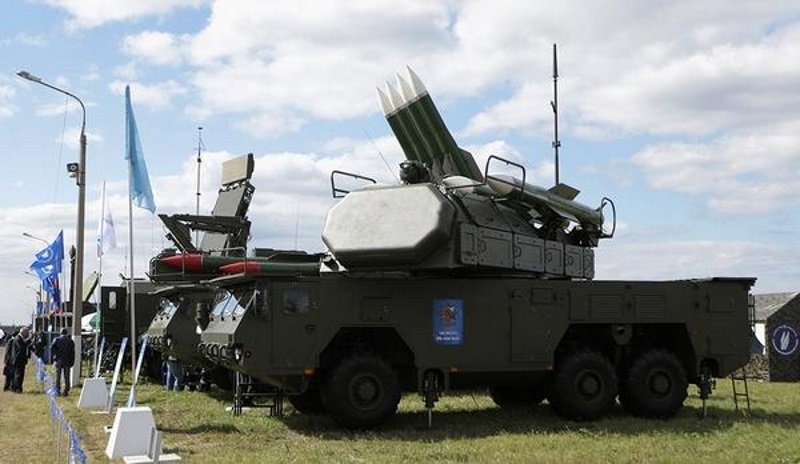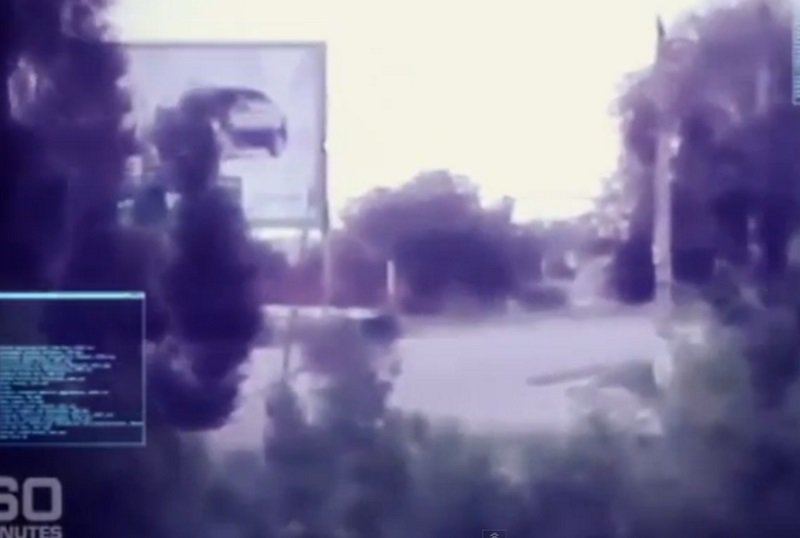
Perhaps it's only fitting that as we reach the second anniversary of the horrific shoot-down of Malaysia Airlines Flights 17, The New York Times would mark the occasion by once more using the tragedy as a propaganda club to advance the neocon goal of a new, costly and very dangerous Cold War with Russia.
On Saturday, the Times again demonstrated its disdain for normal journalistic practices as it picked up an amateur assertion that the Russians had faked satellite imagery showing Ukrainian anti-aircraft missile systems in eastern Ukraine before the civilian airliner was blown out of the sky on July 17, 2014.
Since that moment, the Times and other mainstream Western publications have been determined to pin the blame for the deaths of 298 people on Russian President Vladimir Putin so the world could plunge ahead into the latest neocon scheme of destabilizing nuclear-armed Russia with the eventual aim of "regime change" in Moscow.
As revolting as it has been to watch the deaths of innocents exploited in the name of big-power geopolitics, what has been most troubling from a journalistic perspective is that the Times has cast aside any pretense of professional objectivity, much as it did during the deception of the American public over Iraq's fictitious weapons of mass destruction in 2002-2003.
In this latest burst of anti-Russian propaganda, the Times gives great weight to some bloggers who applied a computer program supposedly to show that two Russian government satellite images were manipulated. The point is to cast doubt on whether the Ukrainian military had missiles in place in eastern Ukraine that could have shot down MH-17.
What the Times leaves out is the fact that Western intelligence has already confirmed that Ukraine's military did have powerful anti-aircraft missiles in eastern Ukraine on July 17, 2014. Last October, a Dutch intelligence report stated that fact based on NATO intelligence gathering, i.e., the West's own satellite and other data collection.
Indeed, the Netherlands' Military Intelligence and Security Service (MIVD) concluded that the only anti-aircraft weapons in eastern Ukraine capable of bringing down MH-17 at 33,000 feet belonged to the Ukrainian government, not the ethnic Russian rebels.
MIVD made that assessment in the context of explaining why commercial aircraft continued to fly over the eastern Ukrainian battle zone in summer 2014. (The MH-17 flight had originated in Amsterdam and carried many Dutch citizens, explaining why the Netherlands took the lead in the investigation.)
MIVD said that based on "state secret" information, it was known that Ukraine possessed some older but "powerful anti-aircraft systems" and "a number of these systems were located in the eastern part of the country." MIVD added that the rebels lacked that capacity:
"Prior to the crash, the MIVD knew that, in addition to light aircraft artillery, the Separatists also possessed short-range portable air defence systems (man-portable air-defence systems; MANPADS) and that they possibly possessed short-range vehicle-borne air-defence systems. Both types of systems are considered surface-to-air missiles (SAMs). Due to their limited range they do not constitute a danger to civil aviation at cruising altitude."Lacking Motive
In other words, the Russians would have no clear motive to doctor satellite photos since accurate ones would have shown the presence of Ukrainian Buk missile batteries in the area. You might have thought that the Times would have considered this fact relevant in evaluating claims from some amateur analysts about whether photos were manipulated or not.

Roger Cozien, designer of the filtering software Tungstene, has warned against rushing to judge "anomalies" in photographs as intentional falsifications when they may result from the normal process of saving an image or making innocent adjustments.
In an interview in Time magazine, Cozien said, "These filters aim at detecting anomalies. They give you any and all specific and particular information which can be found in the photograph file. And these particularities, called 'singularities', are sometimes only accidental: this is because the image was not well re-saved or that the camera had specific features, for example.
"The software in itself is neutral: it does not know what is an alteration or a manipulation. So, when it notices an error, the operator needs to consider whether it is an image manipulation, or just an accident."As Cozien described the process, it becomes clear that the trick of detecting an intentional manipulation rather than some normal or innocuous anomaly — that might occur in transferring an image from one format to another or making contrast adjustments or adding a word box — is more art than science.
And, there is no reason to believe that the Middlebury Institute's arms control researchers have some special expertise in photographic forensics beyond having purchased the Tungstene suite of software upon which they based their report at the "armscontrolwonk.com" Web site.
Double Standards
The report's authors also take the Russians to task for the lack of precision of the two images. "The image files are very poor quality," they write. "We are very disappointed that the Russian Federation, in such an important matter, would release such low quality images as evidence. ... Russian officials must know that releasing images in such a format makes it more difficult to verify the integrity of the images..."
Nevertheless, these researchers make sweeping judgments about the presence of a cloud in one photo and the allegedly sharper image of two Ukrainian Buk missile launchers in the other. Yet, why the Russians would add a cloud makes little sense. (July 17, 2014, was a partly cloudy day in eastern Ukraine, so perhaps the cloud is in the image just because the area was under a partial cloud cover.)
The researchers archly note that "UN Security Council Resolution 2166 calls on states to 'provide any requested assistance to civil and criminal investigations.' ... We believe Russia should provide the original, underlying images in an unaltered form to the Joint Investigative Team [which is conducting the criminal investigation into the MH-17 crash] to allow independent experts to verify their claims."
Sure, of course, but the arms control bloggers don't call on the U.S. government to release its satellite and other intelligence data relating to the MH-17 shoot-down.
The real filter that needs to be applied when dealing with either The New York Times or some of the "citizen journalists" who pop up to reinforce the U.S. government's propaganda themes is their unrelenting anti-Russian bias. Can anyone recall the last time The New York Times or any mainstream U.S. news outlet has presented a favorable or even neutral story about Russia?
The U.S. 'Dog Not Barking'
Along those lines, neither the researchers' report nor the Times' article offers any criticism of the U.S. government, which has claimed to have satellite intelligence showing where the anti-aircraft missile was fired but has refused to release that important information to the public or apparently even to official MH-17 investigators.
On July 20, 2014, just three days after the disaster, Secretary of State John Kerry appeared on all five Sunday talk shows including NBC's Meet the Press where he cited some "social media" to implicate the ethnic Russian rebels in eastern Ukraine and added: "But even more importantly, we picked up the imagery of this launch. We know the trajectory. We know where it came from. We know the timing. And it was exactly at the time that this aircraft disappeared from the radar."
Two days later, the Office of the Director of National Intelligence released a "Government Assessment," also citing "social media" seeming to implicate the rebels. Then, this white paper listed military equipment allegedly supplied by Russia to the rebels. But the list did not include a Buk missile battery or other high-powered anti-aircraft missiles capable of striking MH-17, which had been flying at around 33,000 feet.
The DNI also had U.S. intelligence analysts brief a few select mainstream reporters, but the analysts conveyed much less conviction than their superiors may have wished, indicating that there was still great uncertainty about who was responsible.
The Los Angeles Times article said:
"U.S. intelligence agencies have so far been unable to determine the nationalities or identities of the crew that launched the missile. U.S. officials said it was possible the SA-11 [the designation for a Russian-made anti-aircraft Buk missile] was launched by a defector from the Ukrainian military who was trained to use similar missile systems."That uncertainty meshed somewhat with what I had been told by a source who had been briefed by U.S. intelligence analysts shortly after the shoot-down about what they had seen in U.S. high-resolution satellite photos, which they said showed what looked like Ukrainian military personnel manning the battery which was believed to have fired the missile.
There is also an important distinction to make between the traditional "Intelligence Assessment," which is the U.S. intelligence community's gold standard for evaluating an issue, complete with any disagreements among the 16 intelligence agencies, and a "Government Assessment," like the one produced in the MH-17 case.
As former CIA analyst Ray McGovern wrote:
"The key difference between the traditional 'Intelligence Assessment' and this relatively new creation, a 'Government Assessment,' is that the latter genre is put together by senior White House bureaucrats or other political appointees, not senior intelligence analysts. Another significant difference is that an 'Intelligence Assessment' often includes alternative views, either in the text or in footnotes, detailing disagreements among intelligence analysts, thus revealing where the case may be weak or in dispute."In other words, a "Government Assessment" is an invitation for political hacks to manufacture what was called a "dodgy dossier" when the British government used similar tactics to sell the phony case for war with Iraq in 2002-2003.
However, more relevant to the recent Times article is the fact that the U.S. government has withheld from the public - and even from official investigators - important information for determining the guilty parties and holding them accountable. For instance, neither the Dutch Safety Board, which headed up the initial investigation, nor the Joint Investigation Team (JIT) has been able to pinpoint the site of the missile firing.
Though Kerry insisted that the U.S. government knew that fact three days after the incident, the Dutch Safety Board said last October that it had narrowed the likely firing location only to an area of 320-square kilometers covering territory used by both the rebels and the government. The JIT has promised the families of Dutch victims that it would determine that detail later this year (now more than two years after the shoot-down).
If one wants to apply Sherlock Holmes logic to this "dog not barking" problem, you would probably conclude that the U.S. government clammed up after Kerry's statements and the DNI's sketchy white paper because - as more evidence was uncovered and analyzed - it was not pointing in the direction that U.S. propagandists wanted.
Lacking Balance
Yet, it is Russia, not the United States, that is taken to task for not providing its data in the most pristine fashion, even as the U.S. government provides nothing at all. And whenever the MH-17 issue is raised in the major Western news media, this strange official U.S. silence is ignored or excused while other inconvenient facts are also left out, such as a report by Der Spiegel that the German intelligence service, BND, had found that MH-17 photos supplied by the Ukrainian government "have been manipulated."
Photograph published by the New York Times purportedly taken in Russia of Russian soldiers who later appeared in eastern Ukraine. However, the photographer has since stated that the photo was actually taken in Ukraine, and the U.S. State Department acknowledged the error.
Even more egregious is the blackout that the Times and other news organizations have applied to the Dutch intelligence report regarding the presence of Ukrainian military anti-aircraft batteries in eastern Ukraine capable of bringing down a commercial airliner at 33,000 feet and the rebels lack of such a powerful weapon.
Plus, there have been official disclosures that raise serious doubts about the integrity of the JIT, which has investigators from the Netherlands, Australia, Ukraine, Belgium and Malaysia, but has fallen increasingly under the control of Ukraine's SBU, a security and intelligence agency that is responsible for protecting Ukrainian government secrets and that has been implicated in torture and other war crimes against the ethnic Russian rebels.
Earlier this year, an interim JIT report revealed how cozy the relationship had grown between the SBU and especially the Dutch and Australian investigators who have had long stints in Kiev, getting fed "evidence" by the SBU, and depending on the Ukrainian host's hospitality.
Though this JIT report was released publicly, its contents were ignored by the Times and other publications even amid formal complaints from the United Nations about the SBU blocking human rights investigations into alleged Ukrainian government torture centers.
The SBU's dominance over the JIT would seem to bear on the integrity of the MH-17 investigation, but this fact also doesn't fit the propaganda goal of pinning the deaths of 298 people on Russia. Indeed, it would put whatever the JIT does eventually conclude under the suspicion of bias and possible SBU manipulation.
An Obligatory Hat Tip
And, it seems no Times article on MH-17 would be complete without a tip of the cap to the "citizen journalism" site, Bellingcat, which has made a cottage industry out of reinforcing the West's propaganda themes whether against the Syrian or Russian governments. Bellingcat has remained the beloved Internet site of the mainstream Western media despite a history of getting stories wrong.
Based on information from Eliot Higgins, correspondent Michael Usher of Australia's 60 Minutes claims to have found the billboard visible in a video of a BUK missile launcher after the shoot-down of Malaysia Airlines Flight 17 on July 17, 2014. But the landmarks didn't match.
In Saturday's article, Times reporter Kramer cited Bellingcat as a way to bolster the findings of the folks at "armscontrolwonk.com" without mentioning that Bellingcat's earlier analysis of the "cloud" photo had been criticized by forensics experts for misusing computer software to reach anti-Russian conclusions, or as Der Spiegel reported:
"The research group Bellingcat has accused Russia of manipulating satellite images from the MH17 disaster. But German image forensics expert Jens Kriese has criticized the analysis. He says it is impossible to say with any certainty whether Moscow is lying."It also turns out that both Bellingcat founder Eliot Higgins and "armscontrolwonk.com" have links to the pro-NATO think tank, Atlantic Council, which has been at the forefront of promoting NATO's new Cold War with Russia.

Stein's work on the Syrian conflict would intersect with Higgins's attempts to reinforce Western propaganda blaming the Syrian government for the devastating sarin gas attack outside Damascus on Aug. 21, 2013, which proved to be one of Bellingcat's reporting errors.
On the second anniversary of the MH-17 atrocity, it is sadly not surprising that the Times would continue to grab onto any dubious claim - and present it without meaningful context - as long as the material helps agitate the newspaper's readers into wanting war with Russia.
Investigative reporter Robert Parry broke many of the Iran-Contra stories for The Associated Press and Newsweek in the 1980s. You can buy his latest book, America's Stolen Narrative,print here or as an e-book (from Amazonand barnesandnoble.com).




Reader Comments
to our Newsletter